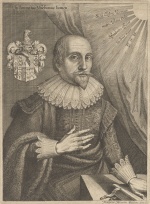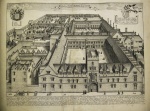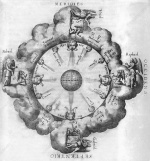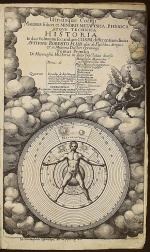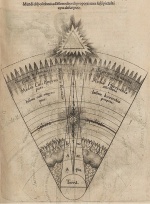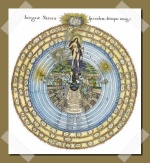Robert Fludd: Difference between revisions
No edit summary |
|||
| (One intermediate revision by the same user not shown) | |||
| Line 99: | Line 99: | ||
• Clavis philosophiae et alchymiae, 1633 | • Clavis philosophiae et alchymiae, 1633 | ||
• Philosophia Moysaica, Gouda 1638, | • Philosophia Moysaica, Gouda 1638, London 1659. | ||
==Online Resources== | ==Online Resources== | ||
| Line 107: | Line 107: | ||
* Robert Fludd and the Image of the Divine by Urszula Szulakowska [[https://publicdomainreview.org/essay/robert-fludd-and-his-images-of-the-divine]] | * Robert Fludd and the Image of the Divine by Urszula Szulakowska [[https://publicdomainreview.org/essay/robert-fludd-and-his-images-of-the-divine]] | ||
* Scientist of the Day - Robert Fludd by Dr. Ashworth [[https://www.lindahall.org/robert-fludd/]] | * Scientist of the Day - Robert Fludd by Dr. Ashworth [[https://www.lindahall.org/robert-fludd/]] | ||
* The World Soul of Early Modern Philosophy by Alison Peterson [[https://www.rochester.edu/college/faculty/alisonpeterman/WorldSoul.pdf]] | |||
* Wikiwand - Robert Fludd [[https://www.wikiwand.com/en/Robert_Fludd.]] | * Wikiwand - Robert Fludd [[https://www.wikiwand.com/en/Robert_Fludd.]] | ||
Latest revision as of 02:05, 3 December 2021
Robert Fludd, also known as Robertus de Fluctibus (* a few days before January 17, 1574 in Bearsted, Kent, England, † September 8, 1637, in London), was a prominent English Paracelsian physician with both scientific and occult interests. Fludd is best known for his compilations in occult philosophy and is remembered as an astrologer, mathematician, cosmologist, Kabbalist and Rosicrucian apologist. [1]He also wrote extensive treatises on various other subjects such as mechanics, architecture, military fortifications, armaments, military maneuvers, hydrology, musical theory and musical instruments, mathematics, geometry, as well as chemistry and medicine. [2]
Fludd’s monumental but incomplete History of the Two Worlds (Utriusque Cosmi ... Historia, 1617-1621), in which he discusses the Microcosm of human life on earth and the Macrocosm of the universe, his Medicina Catholica (1629-1631) and Philosophia Moysaica (1638) represent the culmination of Renaissance Christian Platonism. [3][4]
Early Years
Robert Fludd was born at Milgate House, in the parish of Bearsted and county of Kent, in the year 1574. His father was Sir Thomas Fludd who served Queen Elizabeth for many years and received his Knighthood for his services as War Treasurer in the Netherlands, [5] and his mother Elizabeth was the daughter of Philip Andrews of Wellington. His parents had twelve children, nine of whom lived to adulthood. [6]
Little is known concerning the early life of Robert Fludd. In 1591, the same year Robert Fludd’s mother passed away, he entered St. John's College, Oxford, graduating with a B.A. in 1597 and an M.A. in 1598. St. John’s College was one of the few colleges in England with any provision for Fellowships (medicine), but it remained a center for theological studies. [7] His interest in esoteric topics, his taste for Renaissance occultism and Paracelsianism as well as his practice of astrology most likely began during his studies at St. John [8] and further developed during his six- year journey throughout Europe following his graduation. [9] He visited France, Spain, Italy, and Germany and undoubtedly sought out men and books with views compatible with his own and adding to his collection of Renaissance, Neoplatonic, and Hermetic learning. [10]
Fludd and Medicine
During his six years of study as a medical student he became quite proficient in chemistry but his leaning towards the occult led him also into Paracelsian medical circles during his travels. [11] In addition, he developed a great interest in Rosicrucian philosophy and later was to become one of the movement's most ardent supporters. [12] Upon returning to England in 1604, Fludd matriculated to Christ Church, Oxford and intended to take a degree in medicine. The main requirements to obtain this, at the time, included demonstrating that he had read and understood the required medical texts—primarily those by Galen and Hippocrates. Fludd defended three theses following these texts, and on 14 May 1605, Fludd made his supplication. He graduated with his M.B. and M.D. on May 16th, 1605. [13]
He set up a medical practice in London after graduation and applied for admission to the College of Physicians, the governing body of medical affairs. After several heated exchanges with some of the Censors of the College about Paracelsian versus Galenical medicine and several examinations, he was admitted as a Fellow on September 20th, 1609. He himself served as Censor in 1618, 1627, 1633 and 1634. [14]
Even though he was well versed in Paracelsian medicine and its attendant Christian Neoplatonic-Hermetic alchemical metaphysics, he in fact employed much standard Galenical medicine of the day in his practice. [15] and was considered an established, orthodox medical practitioner, both by his colleagues and by the critics of the College in mid-seventeenth century. [16] [17]
Fludd’s theory of disease was that a wind controlled by an evil spirit excited lesser evil spirits in the air that are always present. The latter may enter the body through the pores or from breathing. If there is a weakness somewhere in the body, the evil forces will attack the bonds that hold the four humours in balance, which causes malady. [18]
Fludd’s medical approach was based on Galenical medicine, Paracelsian Medicine, but was also influenced by different religions. He was a staunch member of the Anglican Church but during his travels he spent a winter with Jesuits, a Roman Catholic order deeply opposed to Protestantism who, nevertheless, tutored Fludd on magical practices. His later publications described a medical practice, almost devoid of chemical remedies but which depended almost solely on prayer and the use of the name of Jesus on the model of the first apostles of Christ. This devotional medicine was supported by a theology derived from the secret mystical teaching of Judaism, the Kabbalah, which Fludd employed in a Christianised form derived from the ideas of the German philosopher, Johannes Reuchlin. In his medicinal incantations Fludd used the Hebrew form of the name of Jesus which, he claimed, possessed immense magical potency. He equated Jesus Christ with the Kabbalistic angel Metattron, the heavenly form of the Jewish Messiah. [19]
Macrocosm and Microcosm
Fludd’s most famous work is the History of the Two Worlds (Utriusque cosmi maioris scilicet et minoris metaphysica,1617-19) published in five volumes by Theodore de Bry in Oppenheim. The two worlds under discussion are those of the Microcosm of human life on earth and the Macrocosm of the universe (which included the spiritual realm of the Divine). [20]
The work deals with the history of the Macrocosm from the abyss, the first Light, through the separations and diversities, to the Microcosm of man. It depicts the separation between the lower world of elements from the lower heavenly realm which in turn is separated from the celestial realm beyond the stars. It is based on the concept that all was created from the Light of God, and as the light emanated farther and farther into darkness, the more darkness subdues the light. [21]
Fludd describes in this work an interconnected universe filled with correspondences and sympathies. The book is famous for its engraved plates that illustrate these connections, such as the wonderful title page, depicting a human form, the microcosm, overlying the planetary spheres, the macrocosm [see image on the left]. [22]
Fludd's concepts of the creative and healing forces of light were illustrated by diagrams, the principles of light and darkness being represented by two intersecting cones [see image on the right]. Within the lozenge shape created by the intersection of the downward and upward pointing cones, Fludd placed the sun, since the nature of this sphere balanced the oppositions of spirit and matter, male and female, sulphur, and mercury.
Fludd's cosmogony was based on the three generative principles conceptualized by Paracelsus in his own alchemy, namely, those of light, darkness, and water, from which emerged the three primary elements that constituted matter, that is, Salt from darkness (as the "prima materia"), Sulphur from light (as the soul) and Mercury from water (as the spirit). [23]
Defense of Rosicrucianism
Fludd was never a member of the Rosicrucians, but his philosophy is Rosicrucian in spirit. [24] He greatly admired them and was in sympathy to the ideals and intent expressed in the Rosicrucian manifestoes. He wrote several works to express this admiration, and thus became known as a Rosicrucian Apologist. [25] One example is the Apologia Compendiaria, in which he argued against the claims of Libavius, a German professor from the University of Jena, that the Rosicrucians indulged in heresy and diabolical magic. [26] This work is in three parts and the different chapters have quotations or mottoes taken from the Confessio Fraternitatis, the Rosicrucian manifesto from 1615. The contents of the work are the germs of Fludd's subsequent writings. These develop his purpose in the Apologia Compendiaria, 'to protect the purity and innocence of the society and to wipe off the spots of shame smeared over the Brethren, as with a stream of pure wisdom.' [27][28]
Fludd’s Critics
Fludd was attacked by several people, among them the astronomer Johannes Keplter, the scientist Marin Mersenne, and the clergyman William Foster, who attacked him as a magician.
Johannes Kepler
The arrival of Fludd’s publications caused a stir among the European intelligentsia. The most prolific dispute of Fludd’s career was with Johannes Kepler, between 1619 and 1623. [29] Fludd had a celebrated exchange of views with Kepler concerning the scientific and hermetic approaches to knowledge. Kepler’s view on cosmic harmony were incompatible with Robert Fludd’s description of nature and the two of them criticized each other.
Fludds’ general standpoint was that true understanding of world harmony is impossible without a knowledge of the alchemical or Rosicrucian mysteries. According to Kepler, only that which is capable of quantitative, mathematical proof belongs to objective science. [30]
Wolfgang Pauli, an Austrian theoretical physicist, Nobel prize recipient, and one of the pioneers of quantum physics, partially translated the exchange between Fludd and Kepler in 1952. He compared the geometrical diagrams in Kepler’s astronomical works to Fludd’s alchemical illustrations. Pauli’s view sparked an interest in the Kepler-Fludd polemic, specifically among historians of science. Pauli came up with a psychological interpretation of the Kepler-Fludd polemic after an extensive correspondence with Carl Gustav Jung. They co-published an essay on synchronicity. The moment of synchronicity would have occurred when Kepler first encountered volume 1 of Fludd’s History of the Two Worlds and saw a triangle fitted between two circles and other similarities between Fludd’s work and his own findings because more than 20 years prior, Kepler suddenly knew how the planetary orbits aligned while teaching a class of students when drawing a triangle fitted between two circles on the board. [31]
Marin Mersenne
The French scientist and author Marin Mersenne accused Fludd of being a magician, an atheist and heretic. [32] But he did not only attack Fludd’s work, but also the work of Paracelsus and John Dee. [33] He objected to an alchemical interpretation of creation. While he saw the value in alchemy, he felt it should remain divorced from Theology and left entirely to medicine and science. In addition, he did not like the idea of Christ being reduced to the angelic world. Fludd countered this as a misinterpretation on Mersenne's part by saying that a single principle manifests in different ways in different realms. Further, that the first light is reflected in the angelic world much like a mirror. Without the first light there would be no reflection, and without the reflection, nothing could be created. [34]
Mersenne was also offended by the concept of Fludd’s anima mundi, the Soul of the World, which Fludd described as “a supreme intelligence” of “an angelic nature”. Fludd argued that there must be an anima mundi that “informs, unifies, and vivifies” nature. Fludd maintained, that if man has a soul, the macrocosm must have a soul as well. The engraving of the anima mundi shows a virgin joined to God by a chain that descend through the levels of the hierarchy of existence. [35]
William Foster
Parson William Foster from England published in 1631 a tract against Fludd’s advocacy of the weapon-salve cure as evil using diabolical forces. The weapon-salve was a preparation applied to the weapon causing a wound, which was believed to aid healing by sympathetic natural magic. Since Foster’s book was in English, Fludd replied in kind with the sixty-eight page Doctor Fludds answer unto M· Foster or, The Squeesing of Parson Fosters Sponge. Fludd rebuked Foster by showing the weakness of his arguments.[36]
Last Years
Fludd died at his home in Coleman Street on September 8th, 1637 at the age of 63, and was buried in Bearsted Church. [37] He never married and left no heirs. However, as Craven, the author of several works on ecclesiastical history
ends his book, "The real successors of a writer like Fludd will be found in those who, assimilating his thoughts, and their results, hand on to others the encouraging hope that a time will come `when all the earth shall be full of the knowledge of the Lord as the waters cover the sea.'[38][39]
Writings
• Tractatus apologeticus integritatem Societatis de Rosea Cruce defendens, Leiden 1617
• Tractatus theologico-philosophicus, Oppenheim 1617
• Utriusque cosmi maioris scilicet et minoris Metaphysica, physica atque technica Historia, Oppenheim, Frankfurt 1617
• Tractatus secundus. De naturae simia seu technica macrocosmi historia, Oppenheim 1618, Frankfurt 1624
• Monochordium Mundi symphoniacum J. Kepplero oppositum, Frankfurt 1622
• Philosophia sacra et vera christiana seu Meteorologia cosmica, Frankfurt 1626
• Sophiae cum memoria certamen, 1629
• Clavis philosophiae et alchymiae, 1633
• Philosophia Moysaica, Gouda 1638, London 1659.
Online Resources
- The Case of Robert Fludd by Dante Diotallevi [[1]]
- Dr. Robert Fludd by Sharon M.W. [[2]]
- Robert Fludd and the Image of the Divine by Urszula Szulakowska [[3]]
- Scientist of the Day - Robert Fludd by Dr. Ashworth [[4]]
- The World Soul of Early Modern Philosophy by Alison Peterson [[5]]
- Wikiwand - Robert Fludd [[6]]
Notes
- ↑ Britannica Academic. Robert Fludd https://academic-eb-com.proxygw.wrlc.org/levels/collegiate/article/Robert-Fludd/34665. Accessed on 11/25/21. For access membership required.
- ↑ Szulakowska, Urszula.Robert Fludd and his Images of the Divine. The Public Domain Review. https://publicdomainreview.org/essay/robert-fludd-and-his-images-of-the-divine Accessed on 11/23/21
- ↑ Huffman, William H. Robert Fludd and the End of the Renaissance Routledge, London and New York, 1988.
- ↑ Godwin, Joscelyn. Robert Fludd. Hermetic Philosopher and Surveyor of Two Worlds.Phanes Press, London. 2005, p. 11
- ↑ M.W., Sharon. Doctor Robert Fludd On: The Alchemy website on Levity.com. http://www.levity.com/alchemy/fludd1.html. Accessed on 11/24/21
- ↑ Huffman, William H. Robert Fludd and the End of the Renaissance Routledge, London and New York, 1988, p. 6
- ↑ M.W., Sharon. Doctor Robert Fludd On: The Alchemy website on Levity.com. http://www.levity.com/alchemy/fludd1.html. Accessed on 11/24/21
- ↑ Huffman, William H. Robert Fludd and the End of the Renaissance Routledge, London, and New York, 1988, pp.12-13
- ↑ M.W., Sharon. Doctor Robert Fludd On: The Alchemy website on Levity.com. http://www.levity.com/alchemy/fludd1.html. Accessed on 11/24/21
- ↑ Huffman, William H. Robert Fludd and the End of the Renaissance Routledge, London and New York, 1988, p. 13.
- ↑ Godwin, Joscelyn. Robert Fludd. Hermetic Philosopher and Surveyor of Two Worlds.Phanes Press, London, 2005, p. 7
- ↑ M.W., Sharon. Doctor Robert Fludd On: The Alchemy website on Levity.com. http://www.levity.com/alchemy/fludd1.html. Accessed on 11/24/21
- ↑ Wikiwand Robert Fluddhttps://www.wikiwand.com/en/Robert_Fludd. Accessed on 11/29/21
- ↑ Huffman, William. Robert Fludd Western Esoteric Masters Series. North Atlantic Books, Berkley, California, 2001, p. 18
- ↑ Huffman, William. Robert Fludd Western Esoteric Masters Series. North Atlantic Books, Berkley, California, 2001, p. 18
- ↑ Huffman, William H. Robert Fludd and the End of the Renaissance Routledge, London, and New York, 1988. P. 18
- ↑ Britannica Academic. Robert Fludd https://academic-eb-com.proxygw.wrlc.org/levels/collegiate/article/Robert-Fludd/34665. Accessed on 11/25/21. For access membership required
- ↑ Huffman, William. Robert Fludd Western Esoteric Masters Series. North Atlantic Books, Berkley, California, 2001, p. 18
- ↑ Szulakowska, Urszula.Robert Fludd and his Images of the Divine. The Public Domain Review. https://publicdomainreview.org/essay/robert-fludd-and-his-images-of-the-divine Accessed on 11/23/21
- ↑ Szulakowska, Urszula.Robert Fludd and his Images of the Divine. The Public Domain Review. https://publicdomainreview.org/essay/robert-fludd-and-his-images-of-the-divine Accessed on 11/23/21
- ↑ M.W., Sharon. Doctor Robert Fludd On: The Alchemy website on Levity.com. http://www.levity.com/alchemy/fludd1.html. Accessed on 11/24/21
- ↑ Dr. Ashworth, Jr., William. <Scientiest of the Day – Robert Fludd Linda Hall Library. https://www.lindahall.org/robert-fludd/ Accessed on 11/20/21
- ↑ Szulakowska, Urszula.Robert Fludd and his Images of the Divine. The Public Domain Review. https://publicdomainreview.org/essay/robert-fludd-and-his-images-of-the-divine Accessed on 11/23/21
- ↑ Godwin, Joscelyn. Robert Fludd. Hermetic Philosopher and Surveyor of Two Worlds.Phanes Press, London. 2005, pp. 10-11
- ↑ M.W., Sharon. Doctor Robert Fludd On: The Alchemy website on Levity.com. http://www.levity.com/alchemy/fludd1.html. Accessed on 11/24/21
- ↑ Huffman, William H. Robert Fludd and the End of the Renaissance Routledge, London, and New York, 1988. P. 45
- ↑ Craven, J.B. Doctor Robert Fludd, William Peace & Sons 1902
- ↑ M.W., Sharon. Doctor Robert Fludd On: The Alchemy website on Levity.com. http://www.levity.com/alchemy/fludd1.html. Accessed on 11/24/21
- ↑ Diotallevi, Dante.The Case of Robert Fludd. Queens University. https://utaj.library.utoronto.ca/index.php/utaj/article/view/28317/21931 Accessed on 11/25/21
- ↑ Pauli, Wolfgang. The Influence of Archetypical Ideas on the Scientific Theories of Kepler. Chapter 5 in: Huffman, William. Robert Fludd Western Esoteric Masters Series. North Atlantic Books, Berkley, California. 2001
- ↑ Diotallevi, Dante.The Case of Robert Fludd. Queens University. Page 44 https://utaj.library.utoronto.ca/index.php/utaj/article/view/28317/21931 Accessed on 11/25/21
- ↑ M.W., Sharon. Doctor Robert Fludd On: The Alchemy website on Levity.com. http://www.levity.com/alchemy/fludd1.html. Accessed on 12/1/21
- ↑ Lachmann, Gary. The Secret Teachers of the Western WorldPenguin Random House, New York. 2015, p. 300
- ↑ M.W., Sharon. Doctor Robert Fludd On: The Alchemy website on Levity.com. http://www.levity.com/alchemy/fludd1.html. Accessed on 12/1/21
- ↑ Peterman, Alison.The World Soul in Early Modern Philosophy https://www.rochester.edu/college/faculty/alisonpeterman/WorldSoul.pdf. Accessed on 12/1/21
- ↑ Huffman, William H. Robert Fludd and the End of the Renaissance Routledge, London and New York, 1988. PAGE 66
- ↑ Godwin, Joscelyn. Robert Fludd. Hermetic Philosopher and Surveyor of Two Worlds. Phanes Press, London. 2005, p. 13
- ↑ Craven, J.B. Doctor Robert Fludd, William Peace & Sons 1902
- ↑ M.W., Sharon. Doctor Robert Fludd On: The Alchemy website on Levity.com. http://www.levity.com/alchemy/fludd1.html. Accessed on 11/30/21
